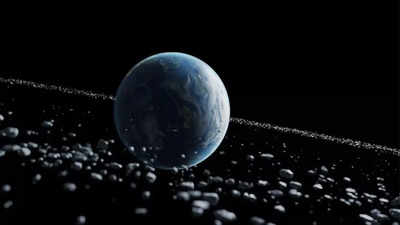Trending
Did Earth once have rings like Saturn?
Approximately 466 million years ago, Earth might have exhibited a spectacular ring arrangement resembling Saturn’s. Recent research featured in Earth and Planetary Science Letters uncovers interesting findings about this ancient ring and its anticipated influence on our planet. While the notion that Earth had a ring arrangement is incredibly exciting, further investigation is required to understand in-depth about its full impact.

Image credit: Oliver Hull/ Monash University
Approximately 466 million years ago, Earth might have exhibited a spectacular ring arrangement resembling Saturn’s. Recent research featured in Earth and Planetary Science Letters uncovers interesting findings about this ancient ring and its anticipated influence on our planet.
The formation of the ring
The ring is believed to have come into existence when a massive asteroid passed close to Earth.
With time, much of this debris was drawn back to Earth by gravitational forces. Smaller fragments likely ignited in the atmosphere, while larger pieces impacted the surface, resulting in the creation of impact craters.
The researchers and scientists have discovered a total of 21 impact craters that can be traced back to the Ordovician period, which is known to be between 488 and 443 million years ago. Notably, all of these craters are situated close to the equator, which is surprisingly unusual, considering that the asteroid impacts usually appear randomly throughout the planet. A professor of planetary science at
It is believed that this accumulation of craters strengthens the argument that a debris ring affected the locations where these impacts manifested.
Climate repercussions
Researchers believe that the presence of a ring around Earth might have had notable effects on the climate. As the ring might have blocked sunlight in the planet’s winter hemisphere, it could have resulted in lower temperatures during those months. On the other hand, summer hemispheres may have experienced comparatively more sunlight and warm temperatures. “...a ring would lead to global cooling effectively acting as a giant parasol”, Tomkins elaborated.
Excitingly, the period of time when the ring was speculated to have existed corresponds with a time of significant cooling on Earth. Approximately 460 to 465 million years ago, global temperatures dropped significantly, ultimately causing the Hirnantian Ice Age, which is believed to be the coldest period in the last half-billion years.
An association with Meteorite impacts
The scientists present the notion that the ring’s presence triggered an increase in meteorite impacts, as debris fragments showered down over millions of years. Tomkins noted, “Over millions of years, material from this ring gradually fell to Earth, creating the spike in meteorite impacts observed in the geological record.” The surge coincides with increased meteorite debris present in sedimentary rock layers from that time.
Looking ahead
While the notion that Earth had a ring arrangement is incredibly exciting, further investigation is required to understand in-depth about its full impact. Researchers intend to develop mathematical models to delve into the details of how asteroids break apart and how the resulting debris would have affected the climate of Earth.
The chance of these types of rings molding our planet’s past offers depth to our insights into the climate behaviour of Earth and indicates that similar events might have occurred in the ancient past. “The idea that a ring system could have influenced global temperatures adds a new layer of complexity to our understanding of how extra-terrestrial events may have shaped Earth’s climate”, as Tomkins explained.
The formation of the ring
The ring is believed to have come into existence when a massive asteroid passed close to Earth.
This occurrence strained the asteroid, causing it to break apart into numerous pieces. These fragments formed a debris ring that encircled Earth’s equator resembling the rings visible around Uranus, Neptune, Saturn, and Jupiter.
With time, much of this debris was drawn back to Earth by gravitational forces. Smaller fragments likely ignited in the atmosphere, while larger pieces impacted the surface, resulting in the creation of impact craters.
Evidence gathered from impact craters
The researchers and scientists have discovered a total of 21 impact craters that can be traced back to the Ordovician period, which is known to be between 488 and 443 million years ago. Notably, all of these craters are situated close to the equator, which is surprisingly unusual, considering that the asteroid impacts usually appear randomly throughout the planet. A professor of planetary science at
Monash University, named Andrew Tomkins stated, “Under normal circumstances, asteroids hitting Earth can hit at any latitude, at random… it’s extremely unlikely that all 21 craters from this period would form close to the equator if they were unrelated to one another.”
It is believed that this accumulation of craters strengthens the argument that a debris ring affected the locations where these impacts manifested.
Climate repercussions
Researchers believe that the presence of a ring around Earth might have had notable effects on the climate. As the ring might have blocked sunlight in the planet’s winter hemisphere, it could have resulted in lower temperatures during those months. On the other hand, summer hemispheres may have experienced comparatively more sunlight and warm temperatures. “...a ring would lead to global cooling effectively acting as a giant parasol”, Tomkins elaborated.
Excitingly, the period of time when the ring was speculated to have existed corresponds with a time of significant cooling on Earth. Approximately 460 to 465 million years ago, global temperatures dropped significantly, ultimately causing the Hirnantian Ice Age, which is believed to be the coldest period in the last half-billion years.
An association with Meteorite impacts
The scientists present the notion that the ring’s presence triggered an increase in meteorite impacts, as debris fragments showered down over millions of years. Tomkins noted, “Over millions of years, material from this ring gradually fell to Earth, creating the spike in meteorite impacts observed in the geological record.” The surge coincides with increased meteorite debris present in sedimentary rock layers from that time.
Looking ahead
While the notion that Earth had a ring arrangement is incredibly exciting, further investigation is required to understand in-depth about its full impact. Researchers intend to develop mathematical models to delve into the details of how asteroids break apart and how the resulting debris would have affected the climate of Earth.
The chance of these types of rings molding our planet’s past offers depth to our insights into the climate behaviour of Earth and indicates that similar events might have occurred in the ancient past. “The idea that a ring system could have influenced global temperatures adds a new layer of complexity to our understanding of how extra-terrestrial events may have shaped Earth’s climate”, as Tomkins explained.
End of Article
FOLLOW US ON SOCIAL MEDIA










